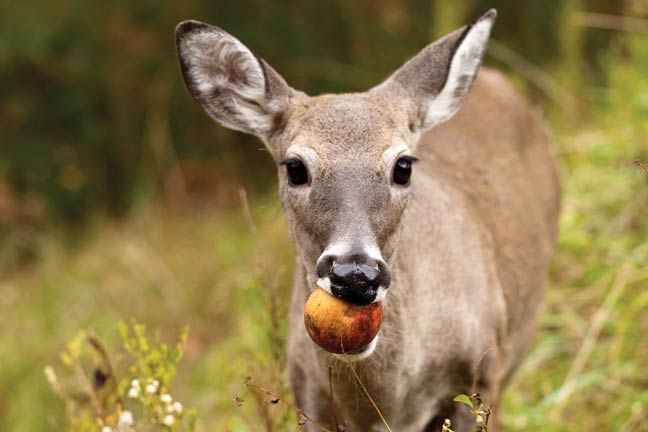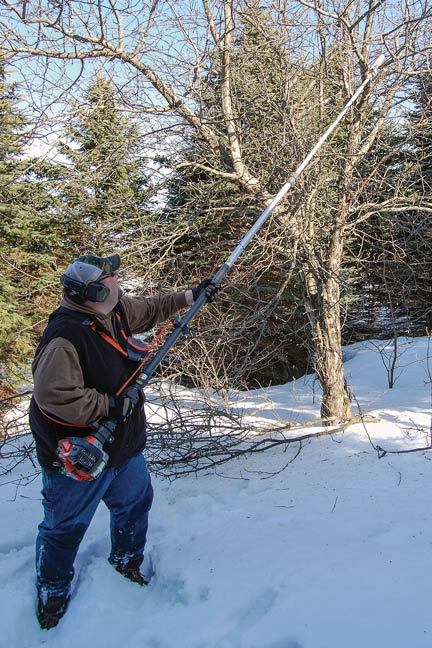For most of us, hunting whitetails isn’t just a seasonal hobby — it’s a year-round obsession. With that obsession comes hard work, and a lot of it, but it’s something we love to do.

When it comes time to put away the bows and firearms, most of us switch back to being managers and stewards of the land, with the goal of improving the habitat and making for a better hunt the following season. Winter can be down time for some other hunters, but for us it’s the right time of year to get out the chainsaw and other tools and get to work on the trees.
Why winter? I know what you’re thinking: It’s cold and nasty out. Why should I get out of this nice, warm house and prune trees? The answer is simple: For the health of the trees, it’s the best time of year to do so.
As you might recall from biology class, a tree pulls water and nutrients up from the soil through its root system. The water ends up with the leaves, where sunlight turns the starches into sugars. Then it flows back down the tree to the roots. Most trees enter a dormant period after their leaves fall away. This is when it’s safest for the tree to be pruned. It’s not that you’re interrupting the flow of water and nutrients that makes this the safe time to prune. It’s that pruning when a tree is active is the easiest way to allow disease to enter.
A plethora of viral and fungal threats can harm or even kill a tree if they get to the core. The only way they can get there is through the bark. So if you open that up, you risk endangering the tree. Does that mean you shouldn’t cut a branch here or there during summer, such as when hanging stands? Not at all. Chances are you’re not going to damage a tree much in the process. They’re resilient.
WHY PRUNE?
There are many reasons to prune a tree. How and why you do it depend on the species and what you’re hoping to get as a result. Fruit trees are different from nut-bearing species. Likewise, hardwoods are different from evergreens with what you can accomplish from pruning.
The basic idea is to allow more light through the tree canopy, resulting in more fruit production. You’re also working to get the tree to put its stored energy into producing fruit and new shoots each season.

All you need to do is drive past a commercial orchard in winter to see pruning is pretty serious business. Why? It’s all about the physiology of the tree. The species we plant to provide food for whitetails store vast amounts of energy each season, and we want to convert that into fruit for the herd.
For example, let’s talk about apple trees. Like other species, they take up water and nutrients from the soil, and sunlight turns carbon dioxide into food for the tree. The roots act as not only a transfer system for the water and nutrients, but also as a “root cellar” during the dormant period, storing all of that energy.
Trees are no different from other plants in that when they grow, they get taller. On a mature tree that’s already producing, taller isn’t always what you want. In fact, what you want is a tree putting all available energy into producing the very things deer want to eat: fruit and new, tender shoots.
There are many similarities between growing bucks and growing fruit commercially. To get your trees to produce more of the very thing you want, you prune. What you’re doing is simplifying the tree, notes Terence Robinson, an applied fruit crop physiologist with Cornell University in Geneva, New York. You prune in earnest when the tree reaches maturity, much as a good deer manager removes bucks after they’ve reached their potential.
In all seriousness, though, most fruit tree varieties reach bearing maturity at around five years of age. At this point, you can start lopping what’s called the “central leader.” This is the branch that forms the top of the tree. If you think of the tree as a line going straight up from the trunk, the central leader is easy to identify.
“As the tree ages, the top tends to overgrow the bottom,” Robinson says. “To prevent this problem and to maintain good light distribution and good fruit quality as trees age, the top of the tree must be kept more narrow than the bottom of the tree.”





